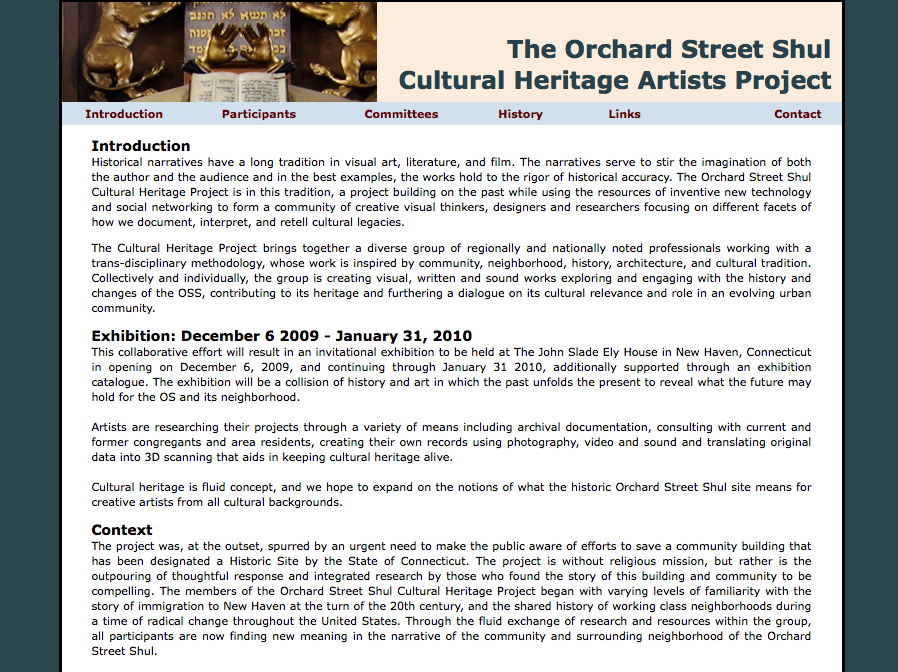The #delValleMural is finally complete!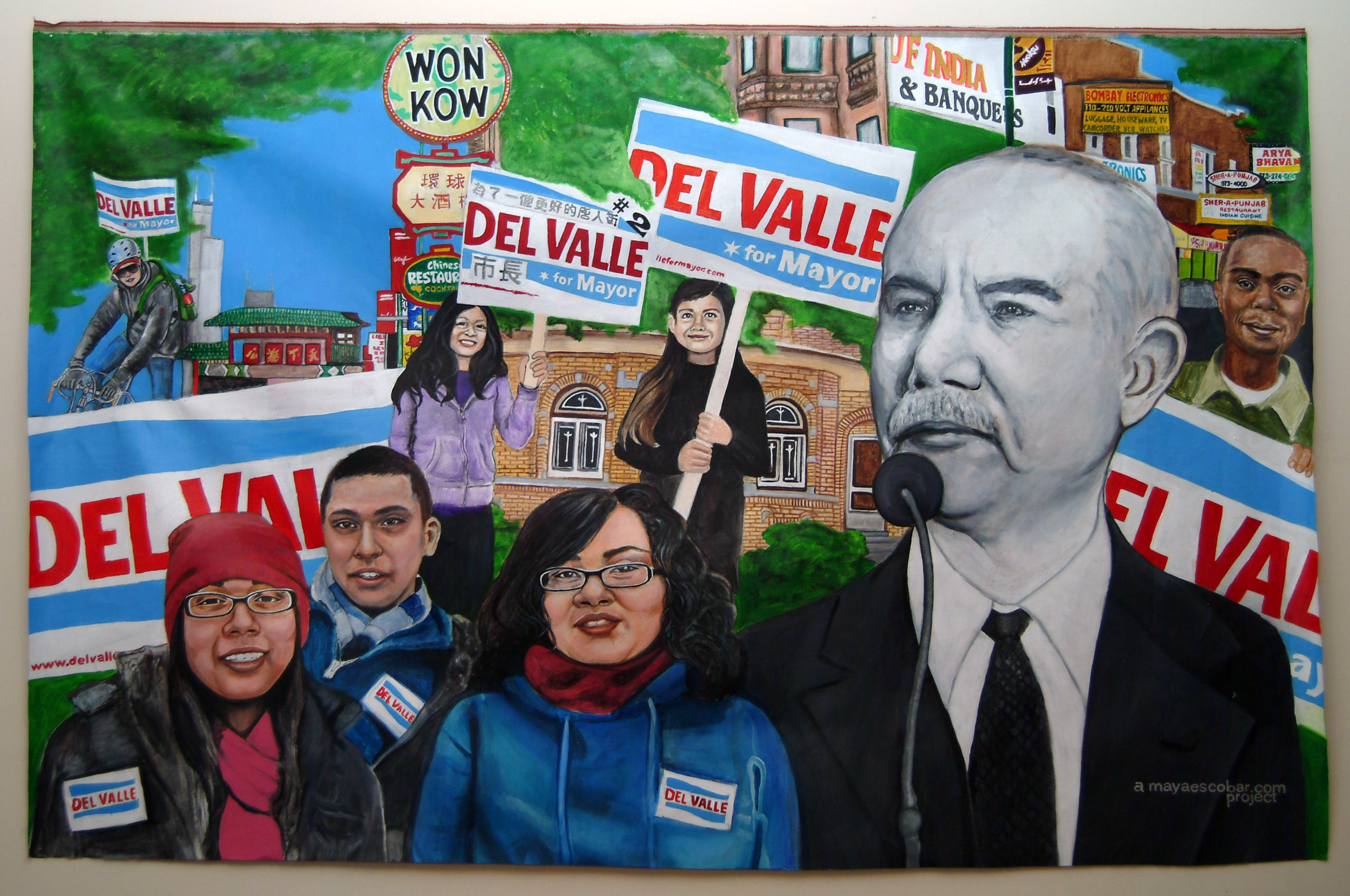 #delValleMural, 2011, Acrylic on CanvasI am thinking that after the elections a Chicago Public Library would be a really nice home for the piece. What do you guys think?
#delValleMural, 2011, Acrylic on CanvasI am thinking that after the elections a Chicago Public Library would be a really nice home for the piece. What do you guys think?
Chicago Does Jibaritos a Cyber Banquet in East Rogers Park
This Saturday my friends and I participated in a Cyber Banquet (virtually) hosted by artists Lisa Link and Io Palmer. Here is a re-post of my post on Lisa and Io's site serve & project, documenting the evenings proceedings.
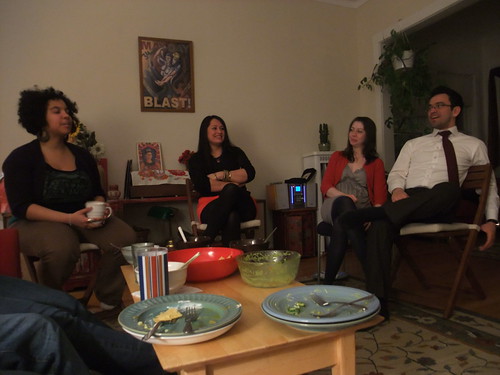 Cyber Banquet hosted in Chicago at Sandi and Stacey's apartment.
Cyber Banquet hosted in Chicago at Sandi and Stacey's apartment.
 Follow the Tamalero on Twitter http://twitter.com/tamaletracker.
Follow the Tamalero on Twitter http://twitter.com/tamaletracker.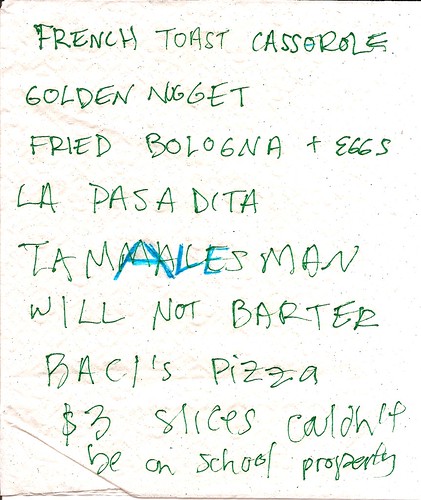
 Caldo de Pollo in the making.
Caldo de Pollo in the making. [youtube=http://www.youtube.com/v/nPr_n5PJ7a0]Chicago Does Jibaritos[youtube=http://www.youtube.com/v/Nd5NhW6V6o0]A New York Bagel[youtube=http://www.youtube.com/v/Nr8Dbbx0E5I]The Pig Roast[youtube=http://www.youtube.com/v/kAKtUfbGNQk]I Lost Myself To Good Cooking
[youtube=http://www.youtube.com/v/nPr_n5PJ7a0]Chicago Does Jibaritos[youtube=http://www.youtube.com/v/Nd5NhW6V6o0]A New York Bagel[youtube=http://www.youtube.com/v/Nr8Dbbx0E5I]The Pig Roast[youtube=http://www.youtube.com/v/kAKtUfbGNQk]I Lost Myself To Good CookingCHAP OPENING 12/6
Show opens 12/6. If you haven't seen it, check out guest post I did on MyJewishLearing.com about my father's and my piece in the show.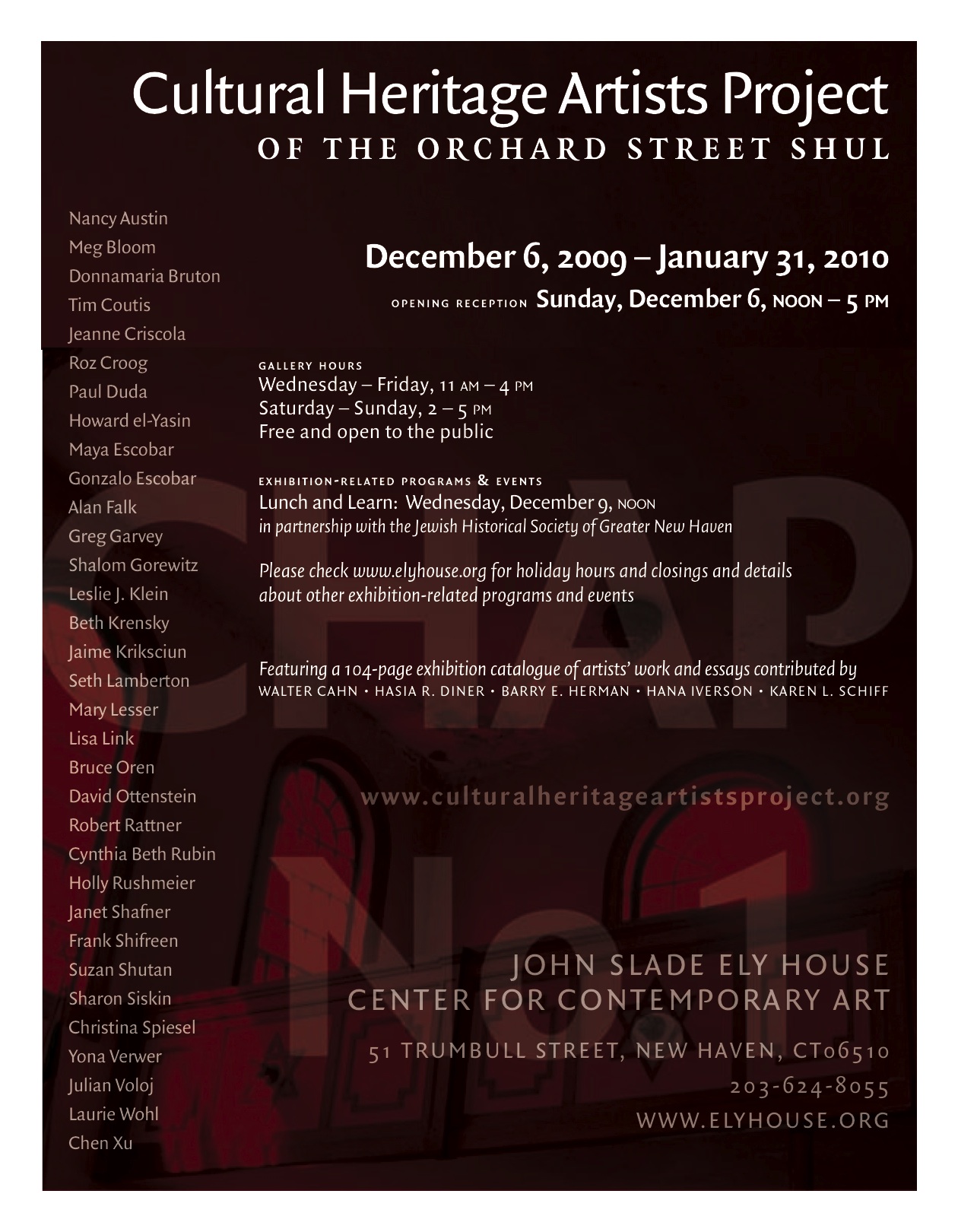
Orchard Street Artist Cultural Heritage Project
My father and I participated in the Orchard Street Artist Cultural Heritage Project.
During the months of December 2009 and January 2010, The John Slade Ely House Center for Contemporary Art in New Haven, Connecticut will come alive with memories, recollections, and recreations of an important community heritage site, in an innovative group installation designed to both stimulate reflection on the legacies of past generations and engage the public in dreams for the future.The Orchard Street Shul Cultural Heritage Artists Project is an art exhibition, a history lesson, a point of cultural exchange, and meeting place for dreamers, both nostalgic and visionary. Artists, researchers, and scholars have joined together to celebrate an important historic New Haven landmark which was once central to the life of a large Jewish immigrant population in the Oak Street neighborhood.Urban changes in the last 50 years have all but erased evidence illustrating the importance of the Oak Street neighborhood in the lives of the newly arrived immigrants and migrants who populated much of the area now known as the "Oak Street Connector", Route 34. Where some see open space, or a new hospital, or a school, or a parking lot, others with longer memories see shops bustling with activity, voices shouting in Yiddish and Italian, sprinkled with a variety of accents from elsewhere, including near and distant regions within the USA.Contributions to the installation offer a range of approaches. Some artists researched the history of the Orchard Street Shul and its neighborhood, uncovering multiple stories of this community: stories of women working together to aid refugees, stories of hard-working fathers and mothers who dedicated themselves to making a better life for their children, and stories of teenagers who giggled and mingled on the steps of the Shul. Others built on their own experiences, reaching into their hearts to create depictions of the Shul that are evocative of deeper connections with history and community. Still others focused on the issues of urban renewal, making real the shifts in our urban landscape that are difficult to imagine as we visit the site today.Included in the Project are presentations by researchers from Yale University who developed innovative ways to document the building, including virtual reconstructions exploring new digital methods, ground-breaking research by computer scientists that promises to change the ways that cultural heritage sites will be documented in the future. Some contributing artists used this digital data in their creative work.The Orchard Street Shul Cultural Heritage Project is organized by Cynthia Beth Rubin, a New Haven based artist, in collaboration with participating artists and researchers: Nancy Austin, Meg Bloom, DonnaMaria Bruton, Jeanne Criscola, Roslyn Z. Croog, Linda Drazen, Paul Duda, Gonzalo Escobar, Maya Escobar, Alan Falk, Greg Garvey, Shalom Gorewitz, Jaime Kriksciun, Leslie J. Klein, Beth Krensky, Seth Lamberton, Mary Lesser, Lisa Link, David Ottenstein, Bruce Oren, Robert Rattner, Cynthia Beth Rubin, Holly Rushmeier, Janet Shafner, Frank Shifreen, Suzan Shutan, Sharon Siskin, Christina Spiesel, Yona Verwer, Julian Voloj, Laurie Wohl, Chen Xu, and Howard el-Yasin. The group includes artists from California, Florida, Utah, Missouri, Rhode Island, Massachusetts, and New York, who traveled to New Haven to contribute to the project alongside artists from the region.A Project Book is being published in conjunction with the exhibition, including essays by Haisia Diner, the eminent scholar of Jewish immigration history, Walter Cahn, renowned historian of art and and architecture, and Hana Iverson, known for her remarkable multi-media installation "View from the Balcony" that was instrumental in helping attract attention to the renovation project of the Eldridge Street Shul. The book will also feature photographs of the works in the exhibition and memories of the Orchard Street Shul, with commentary by Karen Schiff. The innovative book design is by Criscola Design.The Public is Invited to the Opening Reception for the Participating Artists, on Sunday, December 6, from 12:00 Noon to 5:00 pm. To set the mood for the launch of “The Orchard Street Shul Artists Cultural Heritage Project”, the Joseph Slifka Center for Jewish Life at Yale for Jewish Life at Yale will host a Jazz jam session on December 5 at 7:30, celebrating the swing dance music of 1924 and beyond, when the cornerstone of this Synagogue was put in place in a ceremony attended by Mayor Fitzgerald and much of the entire New Haven community.The John Slade Ely House Center for Contemporary Art is open W-F, 11:00 am to 4:00 pm, and weekends 2:00 pm to 5:00 pm. Schools and other organizations who would like to arrange a group visit outside of regular hours may do so by sending an email to: [email protected].
Hope in the STL POST
'Hope' springs anew for Washington University grad students
 November 19, 2008 -- Carianne Noga, a graduate student of art at Washington University, ties tags of hope onto a sculpture outside the University City Post-Office. Noga and fellow student Maya Escobar started soliciting people's hopes to place on the sculpture. (Christian Gooden/P-D)By Margaret GillermanST. LOUIS POST-DISPATCH11/29/2008UNIVERSITY CITY — Georgia O'Keeffe found inspiration in the light and shapes of New Mexico. Mary Cassatt found hers in mothers and children. Maya Escobar and Carianne Noga, two graduate students at Washington University's Sam Fox School of Art and Design, found inspiration for their latest project from the long lines on Election Day at a Ben and Jerry's ice cream shop in the Loop.There, on the sidewalk outside the shop, which was giving away scoops of ice cream to voters, the two women felt excitement and hope among voters. They said they found that same feeling across the street in the long line of voters waiting to vote at the Loop polling place."We wanted to continue that moment and not let it peak out," Noga said.Before the polls closed, they had begun to create their "I hope…" project.They first staked out a site: outside the University City Post Office at 561 Kingsland Avenue.They then provided people with bright red tags and paint markers for them to write down their hopes for a better future.The tags then are affixed to a permanent lattice wood sculpture already on site outside the Post Office."As difficult as it can be sometimes to voice our wishes and dreams, it can be strengthening," the artists say in explaining their mission. "We can be reminded of the rest of the world outside our own immediate concerns. In this period of great change and near infinite possibilities, it is time for us to voice our hopes."While the project is for all people, Escobar said it holds special meaning for young people."This is our moment to make a difference for our communities," Escobar said. "We need to be aware — of our national situation, of the economy."Many of the hopes expressed — most recorded anonymously — so far are noble and universal: "I hope for world peace" and "My hope is that hate is no longer."Some of the hopes are personal. "I hope to not fear death," wrote one.Others have a distinctly political bent: "I hope we get out of Iraq and don't go to war with Iran." And some are just fun, like the person hoping for "chocolate cake for dessert ..."A University City police officer named Hope — Reginald Hope — shared with them his own hope: for safety for police officers. A fellow officer was killed while on duty near the Loop last month.Washington University Chancellor Mark Wrighton gave his hope and "wishes for better health and greater prosperity for all."The artists also are encouraging people to submit their hopes online at togetherwehope.com.The existing sculpture outside the post office was designed in 2005 by an undergraduate architectural design studio taught by Carl Safe in the Washington University School of Architecture. University City resident Ethel Sherman had asked Safe to help create a sculpture in memory of her husband William Sherman, a Washington University biochemist who died about five years ago."It's strong like Bill and peaceful and quiet," she said. Sherman said she's thrilled about adding "I hope..." to it."This is an exciting time of change and hope," said Sherman, a retired psychologist and teacher who worked for 10 years at the Loop's Craft Alliance.The artists, both 24, come from family traditions of public service and political idealism."I grew up under the table of political meetings," says Escobar, remembering her childhood in Chicago. "My friends and I formed our first political organization when we were 11 — Students Against Child Oppression — on behalf of children in sweatshops in Mexico."Her mother is a school nurse, and her father, an educator, hosts a radio show in Chicago called "Si, Se Puede," which means "Yes, We Can." The program has been around since 1996.Noga grew up in the Washington, D.C., area and in Georgia. Her father is a psychiatrist at a state hospital, and her mother is a library director.Both artists are second-year graduate students in the two-year master's of fine arts program.The project will remain up through January. Later, the tags can be relocated to other sites and the online site will remain.University City has embraced the "I hope ..." project, according to city manager Julie Feier."It's an inspiring project," she said.
November 19, 2008 -- Carianne Noga, a graduate student of art at Washington University, ties tags of hope onto a sculpture outside the University City Post-Office. Noga and fellow student Maya Escobar started soliciting people's hopes to place on the sculpture. (Christian Gooden/P-D)By Margaret GillermanST. LOUIS POST-DISPATCH11/29/2008UNIVERSITY CITY — Georgia O'Keeffe found inspiration in the light and shapes of New Mexico. Mary Cassatt found hers in mothers and children. Maya Escobar and Carianne Noga, two graduate students at Washington University's Sam Fox School of Art and Design, found inspiration for their latest project from the long lines on Election Day at a Ben and Jerry's ice cream shop in the Loop.There, on the sidewalk outside the shop, which was giving away scoops of ice cream to voters, the two women felt excitement and hope among voters. They said they found that same feeling across the street in the long line of voters waiting to vote at the Loop polling place."We wanted to continue that moment and not let it peak out," Noga said.Before the polls closed, they had begun to create their "I hope…" project.They first staked out a site: outside the University City Post Office at 561 Kingsland Avenue.They then provided people with bright red tags and paint markers for them to write down their hopes for a better future.The tags then are affixed to a permanent lattice wood sculpture already on site outside the Post Office."As difficult as it can be sometimes to voice our wishes and dreams, it can be strengthening," the artists say in explaining their mission. "We can be reminded of the rest of the world outside our own immediate concerns. In this period of great change and near infinite possibilities, it is time for us to voice our hopes."While the project is for all people, Escobar said it holds special meaning for young people."This is our moment to make a difference for our communities," Escobar said. "We need to be aware — of our national situation, of the economy."Many of the hopes expressed — most recorded anonymously — so far are noble and universal: "I hope for world peace" and "My hope is that hate is no longer."Some of the hopes are personal. "I hope to not fear death," wrote one.Others have a distinctly political bent: "I hope we get out of Iraq and don't go to war with Iran." And some are just fun, like the person hoping for "chocolate cake for dessert ..."A University City police officer named Hope — Reginald Hope — shared with them his own hope: for safety for police officers. A fellow officer was killed while on duty near the Loop last month.Washington University Chancellor Mark Wrighton gave his hope and "wishes for better health and greater prosperity for all."The artists also are encouraging people to submit their hopes online at togetherwehope.com.The existing sculpture outside the post office was designed in 2005 by an undergraduate architectural design studio taught by Carl Safe in the Washington University School of Architecture. University City resident Ethel Sherman had asked Safe to help create a sculpture in memory of her husband William Sherman, a Washington University biochemist who died about five years ago."It's strong like Bill and peaceful and quiet," she said. Sherman said she's thrilled about adding "I hope..." to it."This is an exciting time of change and hope," said Sherman, a retired psychologist and teacher who worked for 10 years at the Loop's Craft Alliance.The artists, both 24, come from family traditions of public service and political idealism."I grew up under the table of political meetings," says Escobar, remembering her childhood in Chicago. "My friends and I formed our first political organization when we were 11 — Students Against Child Oppression — on behalf of children in sweatshops in Mexico."Her mother is a school nurse, and her father, an educator, hosts a radio show in Chicago called "Si, Se Puede," which means "Yes, We Can." The program has been around since 1996.Noga grew up in the Washington, D.C., area and in Georgia. Her father is a psychiatrist at a state hospital, and her mother is a library director.Both artists are second-year graduate students in the two-year master's of fine arts program.The project will remain up through January. Later, the tags can be relocated to other sites and the online site will remain.University City has embraced the "I hope ..." project, according to city manager Julie Feier."It's an inspiring project," she said.
[email protected] | 314-725-6758
together we hope
[youtube=http://www.youtube.com/watch?v=ZcwPoFPdeVM]The polling lines were LONG in STL, I waited over 4 hrs to vote! But it was well worth it, I have never been more proud to be an american and to take part in such an important moment in history.The night of the elections, Carianne and I initiated our project together we hope with the help of our friend Becky Potts. We passed out red tyvek tags and asked people to write down their hopes for the future. We tried to encourage them to go beyond "I hope Obama wins" or I hope McCain wins".People wrote things ranging from "I hope I get good grades" to "I hope that we end the war in Iraq and do not go to war win Iran."Check out this website we created where you can submit your hopes online. We will make a tag for each hope submitted...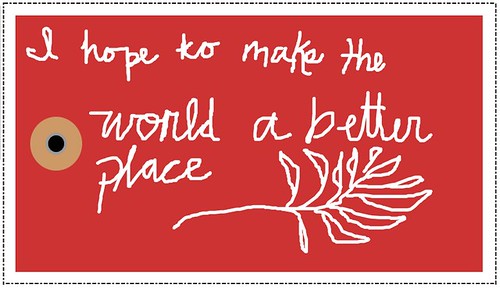
Maya Escobar Paint 4 Peace on ABC 7 News
I just re-uploaded a better quality of this video to youtube, check it out if you missed it before
Paint 4 Peace mural on ABC "The Ñ Beat," with host Theresa Gutierrez back in 2002
Paint 4 Peace is a non-profit organization comprised of artists and activists who strive to create a culture of peace, fortify communities, and bridge the gap between humanity and politics through artistic endeavors.
caminante no hay camino
 There is one specific image that I have never been able to remove from my mind: an image of a Guatemalan solider pointing a gun at the belly of a young pregnant woman. Ironically, I have no recollection as to the source of that specific image. Part of me wonders if that image even existed, or if it was a confabulation of my youth, created in response to the countless stories of political massacre in Guatemala that my father described to me on a regular basis.The Power of ImageRecently I attended a symposium on Architecture, Art and the Experience of Blackness, where I was greatly moved by the words of Hamza Walker, who serves as the Director of Education and Associate Curator for the Renaissance Society at the University of Chicago.In an effort to outline “blackness” or the “black experience”, Walker alluded to the profound impact of the publication of the casket-side Emmett Till photos in JET magazine.The Till incident began with the brutal beating and murder of an 11yr old boy, whose only crime was whistling at a white woman. In a surprisingly high profile trial the two men accused were almost immediately acquitted by an all white jury. The boy’s grieving mother insisted on an open casket funeral so that the world could see what had happened to her beloved son.Walker said, that the media transmission of these transgressions confirmed the collective understanding shared by African Americans that this treatment was the reality of the judicial system. If they were to ever “compromise the integrity of a white woman” what happened to Till would happen to them.Is exposure to explicit images of human brutality the proper way to insure that these incidents do not repeat themselves?How many times have we seen the same iconographic holocaust pictures?But do we know who is in these images and what is taking place?Has seeing the same images a million times done anything the stop the Iraq war or prevent genocide in Darfur?Perhaps the issue comes down to the dissemination of information to young people. Without providing a proper context for the interpretation and dialogue surrounding these explicit images, the depicted incidents become far removed from our lives, and we become numb to their reality.Why a Coloring Book?Coloring Books, emerged in the United States a part of the movement towards the “democratization of education”. They are commonly utilized in popular education models as, accessible teaching tools for often illiterate audiences.This coloring book provides the platform for the introduction and the critical re-evaluation of social movements the context in which they occurred, and the individuals who have preserved and made a major impacts upon the world.
There is one specific image that I have never been able to remove from my mind: an image of a Guatemalan solider pointing a gun at the belly of a young pregnant woman. Ironically, I have no recollection as to the source of that specific image. Part of me wonders if that image even existed, or if it was a confabulation of my youth, created in response to the countless stories of political massacre in Guatemala that my father described to me on a regular basis.The Power of ImageRecently I attended a symposium on Architecture, Art and the Experience of Blackness, where I was greatly moved by the words of Hamza Walker, who serves as the Director of Education and Associate Curator for the Renaissance Society at the University of Chicago.In an effort to outline “blackness” or the “black experience”, Walker alluded to the profound impact of the publication of the casket-side Emmett Till photos in JET magazine.The Till incident began with the brutal beating and murder of an 11yr old boy, whose only crime was whistling at a white woman. In a surprisingly high profile trial the two men accused were almost immediately acquitted by an all white jury. The boy’s grieving mother insisted on an open casket funeral so that the world could see what had happened to her beloved son.Walker said, that the media transmission of these transgressions confirmed the collective understanding shared by African Americans that this treatment was the reality of the judicial system. If they were to ever “compromise the integrity of a white woman” what happened to Till would happen to them.Is exposure to explicit images of human brutality the proper way to insure that these incidents do not repeat themselves?How many times have we seen the same iconographic holocaust pictures?But do we know who is in these images and what is taking place?Has seeing the same images a million times done anything the stop the Iraq war or prevent genocide in Darfur?Perhaps the issue comes down to the dissemination of information to young people. Without providing a proper context for the interpretation and dialogue surrounding these explicit images, the depicted incidents become far removed from our lives, and we become numb to their reality.Why a Coloring Book?Coloring Books, emerged in the United States a part of the movement towards the “democratization of education”. They are commonly utilized in popular education models as, accessible teaching tools for often illiterate audiences.This coloring book provides the platform for the introduction and the critical re-evaluation of social movements the context in which they occurred, and the individuals who have preserved and made a major impacts upon the world.
Beverly A. Normand and the Rald Institute
Rald Institute's mission is to assist at risk children and individuals with learning, social-emotional, and other disabilities. We strive to enhance self-worth while strengthening cognitive and affective domains. We work to increase public awareness of various disabilities and function as advocates. The institute supports schools by providing technical assistance to staff. Rald provides experiences in the arts because we believe such experiences help children expand critical thinking, increase imagination and develop an appreciation for cultural diversity. Inclusive art workshops are offered at no cost to children. The institute is run by volunteers and there are no charges for services to individuals.
here is a link to an abc special on Beverly's work.
Beverly Normand, Ph.D., Founder and President, is a consultant for public and private schools in Illinois, and is lecturer and adjunct professor for several universities. She recently retired from the Office of Specialized Services, Chicago Public Schools, after thirty-four years of service as Special Education Teacher, Citywide Instructional Specialist, and Facilitator for School Based Problem Solving/Response to Intervention programs in Psychology and Special Education. She earned degrees from Roosevelt University, DePaul University and Chicago State University. She was a contributing writer for several publications of Chicago Public Schools, is the recipient of numerous educational awards, special recognitions, and various grants. She has written and hosted several educational television programs, has been published in numerous journals and magazines and has participated in various research projects.
A poet, designer, lyricist and patron of the arts, she has collaborated with artists and musicians on special projects and has planned and coordinated cultural programs and art exhibitions for school children, churches and other institutions throughout her adult life.
Serving as Commissioner of Religion and Race for the United Methodist Church in the South Shore Community of Chicago for twenty years, Normand developed activities and programs to support African American history and culture, while also planning activities and programs to strengthen multi-cultural exchange and diversity training. She served as editor for the Nimbus publication for many years.
Normand has helped thousands of pupils, parents, teachers, ancillary teams and school administrators, and is highly respected for her integrity, creativity and skills. "I believe in interdisciplinary instruction and all curricula that stimulate the imagination and lead us away from mediocrity and complacency. The mission of Rald Institute is to reduce the at-risk population, support children and individuals with special needs in a manner which leads to self-actualization, support as many parents and teachers as we can, and help twenty-first century educational leaders maintain integrity and democratic forms of leadership, while problem solving."
ARTE ≠ VIDA: ACTIONS BY ARTISTS OF THE AMERICAS
Last weekend Carianne and I went to NY for the 2008 Whitney Biennial. As we expected from a survey of Contemporary American Art, not everything in the exhibition appealed to us. However neither of us was disappointed because we were not expecting to be unilaterally wowed. Upon leaving the Whitney, we got into an in-depth discussion about individuals' preconceived expectations, and the role they play in the determining interaction/interpretation/enjoyment, with actual works of art. Soon after this conversation, I was put to the test. As any young MFA student (traveling to New York) who has any hopes of some day having a career, Carianne and I were preparing to leave our hotel, to visit the elusive Chelsea Galleries, when I came upon an announcement for a show at El Museo Del Barrio, ARTE ≠ VIDA: ACTIONS BY ARTISTS OF THE AMERICAS
“Arte no es vida” surveys, for the first time ever, the vast array of performative actions created over the last half century by Latino artists in the United States and by artists working in Puerto Rico, the Dominican Republic, Cuba, Mexico, Central and South America.
Many of the works included in Arte ≠ Vida have subtle or overt political contexts and content: military dictatorships, civil wars, disappearances, invasions, brutality, censorship, civil rights struggles, immigration issues, discrimination, and economic woes have troubled the artists’ homelands continuously over the past four decades and therefore have infiltrated their consciousness. According to curator Deborah Cullen, “the exhibition title challenges the commonplace idea that art is equivalent to life, and life is art. What is proposed through these many works is that while art affirms and celebrates life with a regenerative force, and sharpens and provokes our critical senses, artistic actions which address inequalities and conflict are not equivalent to real life endured under actual repression.”
Over 75 artists and collectives are represented in Arte ≠ Vida, including ASCO, Tania Bruguera, CADA, Lygia Clark, Papo Colo, Juan Downey, Rafael Ferrer, Guillermo Gómez-Peña, Alberto Greco, Alfredo Jaar, Tony Labat, Ana Mendieta, Marta Minujin, Raphael Montañez-Ortiz, Hélio Oiticica, Tunga and contemporary practitioners including Francis Alÿs, Coco Fusco, Regina José Galindo, Teresa Margolles and Santiago Sierra. The exhibition is arranged in four major sections, in which each decade is represented by several specific themes that often cross national boundaries. 1960-1970 looks at select precursors, signaling, destructivism and neoconcretismo; 1970-1980 considers political protest, class struggle, happenings, land/body relationships and border crossing; 1980-1990 focuses upon anti-dictatorship protest and dreamscapes; and 1990-2000 references the Quincentenary, multiculturalism, postmodernism and endurance. An additional section highlights interventions that artists have carried out on television over the past 20 years. In these chronological, thematic groupings, viewers will be able to explore the interconnections among various artists’ actions as well as the surges of activities triggered by specific events in certain countries.
I didn't know what to do. This sounded to good to be true, but we also knew we were supposed to visit the Chelsea Galleries. I considered just buying the catalogue to the exhibition and skipping the show. I don't know if it was faith or instinct that got us there, but I can say with out any doubt in my mind that this was single handedly the best exhibition I have ever attended.
"¿Quién puede olvidar las huellas?," Regina Galindo. 2003.
Galindo walking through the streets of downtown Guatemala City, wetting her feet in a blood-filled bucket, and leaving a path of footprints from the Constitutional Court building to the Presidential Palace, where she was welcomed by a police battalion. The Court had just validated former dictator Efraín Ríos Montt, the country’s foremost author of genocide, as a presidential candidate.
[youtube="http://uk.youtube.com/watch?v=D46p71QdCTc"]

Oscar Bony (1941-2002) hired a working-class family at twice their going wage to pose in a Buenos Aires gallery as a living work of art
[youtube=http://uk.youtube.com/watch?v=8N5xbLtokZY]
"Arte Reembolso/Art Rebate" by Elizabeth Sisco, Louis Hock and David Avalos. 1993.


[...] "The current economic recession has been debilitating for many artists regardless of the content of their work. Since this climate is characterized by a particular hostility toward controversial art, it is especially significant that Elizabeth Sisco. Louis Hock. and David Avalos have maintained a reputation for causing trouble in San Diego. Their collaborative public art projects receive scandalous reports in local and national news media and are often used as examples of the National Endowment for the Art' inadequate standards of quality. Their most current collaborative project Art Rebate (1993) refunded $10 bills to 450 undocumented workers along the San Diego, California/Mexico border. It was commissioned by the Museum of Contemporary Art, San Diego and Centro Cultural de la Raza as part of the "La Frontera/The Border" exhibition. In response to recent attention to border relations due to NAFTA and other government policies, the artists wished to refute the popular misconception that undocumented Mexican workers do not pay taxes as well as demonstrate. albeit with a small symbolic gesture, their appreciation of the undocumented as valued members of Western states, communities. Furthermore, I believe their work has significant implications for undocumented workers from other nations, residing in other regions of the United States - Caribbean workers in Florida and New York City, for example. If the communities in which the undocumented workers from these areas work and reside could also acknowledge their common contributions, in the form of taxes among other things, then perhaps we as a society could also begin to address the crimes inflicted upon these groups and apply our democratic notions of human rights to those within our national borders. [...]
"The projects are clearly controversial. That's not an accident. It's not as if someone latches onto the projects and holds them up as problematic. We intend to create something that is provocative and engenders a public discussion. It is public art, not art in the public. The work is defined by its performance in the community. The public discussion is crucial to the project. In order to begin a discussion we initiate an action - for example, a bus poster or a $10 rebate - that starts the ball rolling. We definitely aim to draw in the broadest spectrum of people, including those in power for the discussion. Obviously the media is not a neutral mechanism for communicating the events that unfold during the projects: it has an agenda that shapes its participation in the discussion. For example, much of the language used to describe Art Rebate in the press was the same inflammatory rhetoric promoted and laid out by the politicians who had given a profile of blame to the undocumented. Similarly, the press had a hard time imagining, and therefore was unable to fairly convey, the undocumented as taxpayers. The press was invited to experience the act of rebating these signed $10 bills. They were encouraged to ask the opinion of undocumented workers concerning their status as taxpayers, but the responses failed to appear prominently in the news media. The media coverage was not a means of evaluating the project but rather a component of the project. Their viewpoints describe a conceptual social space in which they situate the taxpayer and the undocumented in different realms."
"The Parthenon of Books/Homage to Democracy, Buenos Aires," Marta Minujín. 1983.
In December 1983 the Argentine Conceptual artist Marta Minujin and a group of helpers spent 17 days building a full-scale model of the Parthenon in a public park in Buenos Aires, Roberta Smith writes. Except for a metal scaffolding, it was made almost entirely of books wrapped in plastic. All the books had been banned by one of the most oppressive juntas in the country’s history, which was just being dismantled after Argentina’s first democratic election in a decade. “The Parthenon of Books/Homage to Democracy,” as Ms. Minujin’s work was titled, stood for about three weeks. Then the public was allowed to disassemble the piece and keep the books.
partenon de libros marta minujinAvenida 9 deJulio y Avenida Santa Fe. Buenos Aires. Argentina. Concebida como un monumento a la democracia y a la educación por el arte, Partenón constaba una estructura metálica, réplica del partenón, recubierta con prohibidos durante la dictadura militar.


[...]In a similar fashion to the live human spectacles of the past, Fusco and Gomez-Peña performed the role of cultural "other" for their museum audiences. While on display the artists' "traditional" daily rituals ranged from sewing voodoo dolls, to lifting weights to watching television to working on laptop computers. During feeding time museum guards passed bananas to the artists and when the couple needed to use the bathroom they were escorted from their cage on leashes. For a small donation, Fusco could be persuaded to dance (to rap music) or both performers would pose for Polaroids. Signs assured the visitors that the Guatinauis "were a jovial and playful race, with a genuine affection for the debris of Western industrialized popular culture . . . Both of the Guatinauis are quite affectionate in the cage, seemingly uninhibited in their physical and sexual habits despite the presence of an audience." Two museum guards from local institutions stood by the cage and supplied the inquisitive visitor with additional (equally fictitious) information about the couple. An encyclopedic-looking map of the Gulf of Mexico, for instance, showed the supposed geographic location of their island. Using maps, guides, and the ambiguous museum jargon, Fusco and Gomez-Peña employed the common vocabulary of the museum world to stage their own display[...]
"Construction of a Traditional Rural Oven,'' Víctor Grippo y Jorge Gamarra. 1972.
CONSTRUCCION DE UN HORNO POPULAR PARA HACER PAN
Intención: Trasladar un objeto conocido en un determinado entorno y por determinada gente, a otro entorno transitado por otro tipo de personas.Objeto: Revalorizar un elemento de uso cotidiano, lo que implica, además del aspecto constructivo escultórico, una actitud.Acción:a) Construcción del Hornob) Fabricación del Panc) Partición del Pan.Resultante pedagógica: Describir el proceso de construcción del Horno y de la fabricación del Pan. Distribuir una hoja. Será posible la participación del público mediante un intercambio de información.
"Untitled (Body Tracks),'' Ana Mendieta. 1974.

Guest Post by Debbie Wolen: Ta'anit Esther and Mardge Cohen
Guest Post by Debbie Wolen*: Ta'anit Esther and Mardge CohenI had never heard of the holiday [Ta'anit Esther] until one year ago, when Rabbi Brant said that the JRF and the RRC wanted to honor Dr. Mardge Cohen for Ta'anit Esther. Mardge asked me what Ta'anit Esther was. I had never heard of it, and I have been Jewish all my life.Isaac Saposnik is working on the Philadelphia side of this RRC/Kolot "reconstruction" of Ta'anit Esther as a Jewish Day of Justice. Ta'anit Esther is described in the Book of Esther (which I did actually read for the first time, in preparation for organizing this event. It describes Esther's initial reluctance to get involved with advocating for her people. When Mordicai first told Esther about the plot, she was afraid to intervene. Apparently, her conscience and sense of justice/solidarity/responsibility was stronger than her fear, and gave her the energy and courage to intervene. Her struggle is interesting and a process that I know I face often in my life, so I can really identify with Esther's struggle. Prior to her intervention, Esther fasted, and asked the whole Jewish community to fast with her in solidarity. Thus, the Fast of Esther is one of several Jewish fast days. (It lasts from sunrise to sundown on March 20. That is why we are having East African (Ethiopian) hors d'ouerves at the March 19 observance.)I bought an Art Scroll prayer book recently, so I looked, and sure enough, Ta'anit Esther is listed as a fast day. It is not described as a Jewish day of justice, however. This is the new reconstruction of it. I also mentioned it to an Israeli fellow, and he said, "Oh, yes, sure, Ta'anit Esther, of course." But, I have asked other people who are much more knowledgeable and involved Jewish people than I, and they had not heard of Ta'anit Esther previously.When I read the Book of Esther, I was somewhat concerned about the justice described there and the assumptions I made about what the reconstructionists meant by "Jewish day for justice." The justice in Esther is revengeful and quite bloody! I asked Isaac about this. He said this Jewish Day for Justice implies social justice, the type of justice that Mardge Cohen and others in Rwanda are working for, making the lives of the survivors of the 1994 genocide better, making the lives of the poor and powerless more empowered. Well, it was obvious, but the bloody revenge in Esther is called justice, too.Mardge Cohen, MD, is a woman who has struggled with social injustice during her whole medical career. She is really a remarkable woman, and her work is on the level of Paul Farmer, in my opinion. I saw some slides she showed at our workplace in 8/2000, of her tour of HIV projects in South Africa after the 2000 International AIDS conference. I was inspired by her slides so that I started trying to educate folks at JRC about AIDS in Africa, and to raise funds for HIV projects there. I am just one of many she has inspired by her example.Here is a jewish text study by Jordan Appel Ta’anit Esther text studyThanks a lot for your interest and supportDebbie Wolen
*About Debbi:
I'm a family nurse practitioner, have worked in HIV primary care at Cook County Hospital for nearly 17 years with people who are medically indigent and suffer the indignities of poverty. I was a public health nurse before that. I have sought inspiration from many sources. My first source of inspiration was my childhood rabbi, Leonard Mervis, who gave sermons on social justice, anti-war and in support of the civil rights movement (like you, my parents insisted on my attendance through high school, every single Friday evening! So, rather than be bored, I listened to the interesting sermons.) I am a product of Cicero, Illinois. My cousins marched against Martin Luther King when I was 15. That was a radicalizing experience that affects me even today, in my middle age. Also, your mother [Tina Escobar] was the only teacher I could really relate to in my two years at Rush College of Nursing, and she only taught our class for 2 weeks!
The Cuentos Foundation
I just submitted the work of Michele Feder-Nadoff, to the magazine I work for Zeek. Michele is a dear friend and a phenomenal artist, activist and educator. I thought it would be a good idea to share some information about Michele and to promote her organization the cuentos foundation.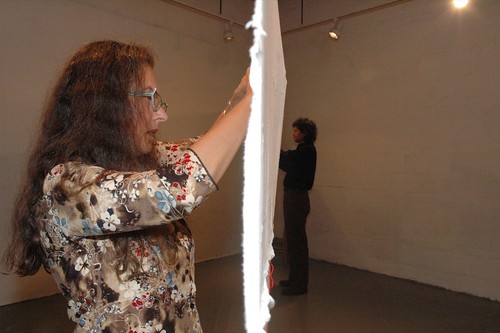 Artistic Director, Michele Feder-Nadoff, who is Jewish, founded Cuentos in 1998 with the humanist vision and commitment to tikkun haolam, a Jewish principal expressing each person’s responsibility to play a part in "healing the world." Cuentos members believe art is a transformative catalyst for effecting positive social change. Our work combats prejudice and discrimination through artistic and educational intergenerational projects and programs promoting mutual understanding.The abundance of cultural wealth living doorstep to doorstep in our neighborhoods provide all of us an opportunity to engage with and learn about each others' backgrounds. What connects us and how can live in peace together, connected by mutual understanding and appreciation of different cultures from around the globe?
Artistic Director, Michele Feder-Nadoff, who is Jewish, founded Cuentos in 1998 with the humanist vision and commitment to tikkun haolam, a Jewish principal expressing each person’s responsibility to play a part in "healing the world." Cuentos members believe art is a transformative catalyst for effecting positive social change. Our work combats prejudice and discrimination through artistic and educational intergenerational projects and programs promoting mutual understanding.The abundance of cultural wealth living doorstep to doorstep in our neighborhoods provide all of us an opportunity to engage with and learn about each others' backgrounds. What connects us and how can live in peace together, connected by mutual understanding and appreciation of different cultures from around the globe?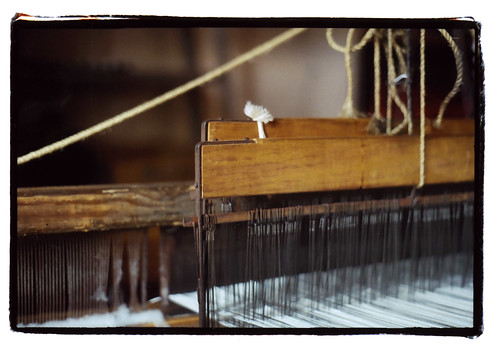
|
check out their new book: Ritmo de Fuego
Ritmo del Fuego / Rhythm of Fire is a unique achievement, telling the story of the deep-seated copperworking tradition of Santa Clara del Cobre, an ancient community in the forested mountains of Michoacán, Mexico. What is often seen as “folk art” is shown to stem from early workshops established in Michoacán during the 8th-9th centuries AD, by coastal traders and artisans from the Andean Region of South America. Since then, the manufactures have included utilitarian and ornamental objects. Many have been recovered at archaeological sites, most notably from the 15th century Tarascan Kingdom. Others embrace forms of Spanish origin after the 16th century conquest. Today in the expanding international market, Santa Clara copperwares include a wide range of sophisticated decorative vases, pitchers, trays, dinner wares and related forms. A vital community has evolved with this ongoing tradition, portrayed with affection and care by the project organizer Michele Feder-Nadoff, and the many other authors in this remarkable, well written contribution to the cultural history of the Americas.
click here to purchase
